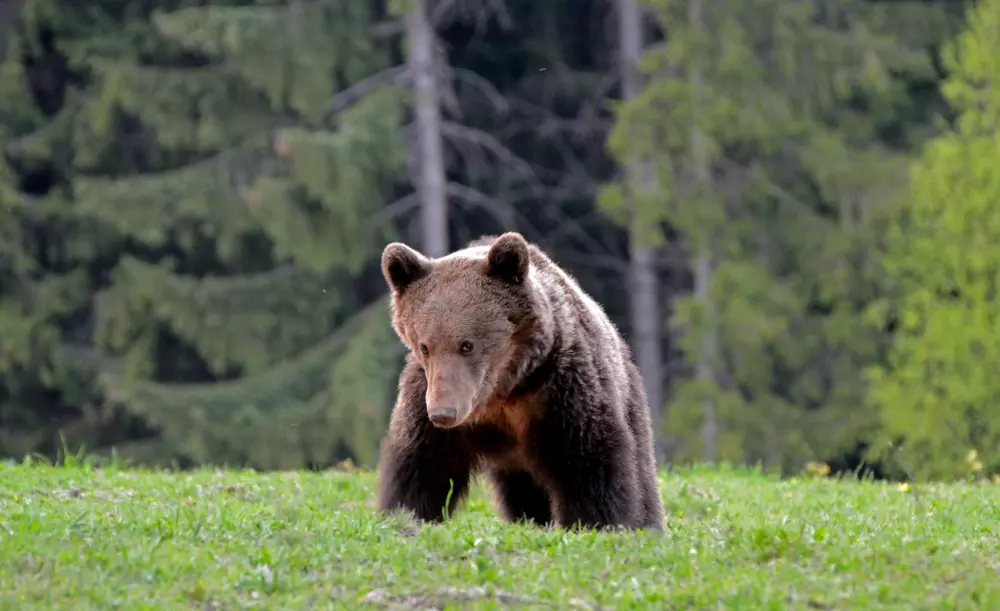The Washington Department of Fish and Wildlife (“the Department”) has been allowing the baiting and killing of endangered wolves. It’s also allowing the baiting and hound hunting of black bears despite a voter-approved ballot measure that forbids these practices except in extreme circumstances.
Department personnel will emphatically deny they are allowing baiting. But the facts, viewed in the context of the Department’s obedience to timber and livestock interests, tell us otherwise.
First the bears.
In 1996, I led a citizen ballot initiative in Washington to ban the baiting of bears and the hound hunting of bears and cougars. Four years later, I worked with colleagues to assemble a coalition to qualify and pass a second ballot initiative to halt the use of steel-jawed leghold traps and other body-gripping traps.
In both election fights, solid majorities of voters agreed that it’s hardly sporting to shoot a bear with his or her head in a barrel full of jelly doughnuts and meat scraps or to chase bears or cougars with packs of dogs, force the quarry climb a tree, and then shoot the frightened, panting animal out of the tree at point-blank range. They also agree that steel traps are cruel and indiscriminate, even catching family pets, endangered animals, and other “non-target” wildlife.
That baiting and hounding ballot measure, approved by 63 percent of voters and passing in 31 of 39 counties, had narrow allowances to use these methods to kill individual bears posing a threat to people or property. The anti-trapping measure passed by 10 points, and it also had narrow exceptions for using the traps only after exhausting all non-lethal methods.
In recent years, as documented by KING-5 TVin its reporting, the Department and the timber industry have taken that narrow exemption and turned it on its head. They are overseeing a killing program allowing baiting, hounding, and trapping of bears on vast tracks of private timber lands in defiance of law. In fact, internal documents unearthed by the Center for Biological Diversity and other wildlife protection organizations reveal that Department personnel concede that the hunters target male bears even though females primarily girdle trees. Post-mortem examinations of bears reveal that three quarters of them have no bark in their stomachs.
The timber companies don’t like when girdling happens at all, and in response they won an allowance from the Department to conduct “supplemental feeding” (baiting) on private lands – a practice that draws more bears to the tree stands that Weyerhaeuser and other companies want to protect. Then the hound hunters come in and finish off the bears, most of whom have no sap stuck between their teeth or bark shards between the claws.
Why is Governor Jay Inslee letting his Department get away with this rogue wildlife management scheme? It’s not a small matter. Of the 22 million acres of forestland in Washington, about 4 million acres are privately owned and managed by timber companies and other forest and forest product companies.
Sadly this is just one example of the Department again subordinating the interests of wildlife to the whims of private resource users.
Wolves have also been in the bright lights of the public.
Though there is high-minded talk of “stakeholder engagement” and “mitigating human-wolf conflicts,” the Department is allowing much of its wolf policy to be driven by the leaders of the Diamond M Ranch, a cattle company. This McIrvin family, the ranch’s owners, are essentially baiting wolves with live cattle on our public lands. And then they complain when the inevitable occurs.
It’s baiting alright. Live animals. No jelly doughnuts. But it’s baiting.
The McIrvins don’t want to see a single wolf alive, and they’ve said so. This is their way of killing off the wolves without pulling the trigger themselves.
Other packs previously inhabited the rugged expanses of the Colville National Forest, and the state has already wiped them out — pack after pack. In July and August, the state killed eight wolves from the Old Profanity Territory pack.
Maybe some surviving wolves will find their way back to the Colville. If they do, more killing will occur if the Forest Service keeps allowing grazing in prime wolf habitat, if the McIrvins keep sacrificing their cattle in order to secure new kill orders for wolves, and if the state continues its strategy of appeasement to private resource users.
Many Washingtonians would swallow hard but nevertheless accept the idea of an occasional lethal action to deal with a wolf or a bear who developed a habit of killing livestock or girdling trees. But sensible people reject the idea of the state eliminating entire wolf packs and unoffending bears because a ranching baron or timber industry magnate says that’s the way it’s got to be.
Washington voters said they want bears and cougars protected, but the Department has subverted that law time and again. It listed wolves as endangered but hardly treats them as the small, recovering population they are.
State fish and wildlife agency personnel are typically schooled to think in terms of populations, not individuals. It may not matter to them if they kill a bunch of wolves or bears, knowing other animals survive elsewhere. But sensible people know that bears feel pain and experience fear and suffering. They know that wolves cherish their family members and grieve for the loss of their kin.
Perhaps the state acknowledges that latter fact too. And that’s why they often wipe out entire families, leaving not a single member alive.

Washington State Continues War on Predators, Despite Law and Public Sentiment Demanding Their Protection
- Wayne Pacelle
Dear reader: If you support substantive policy work to protect animals, please consider donating to Animal Wellness Action today. You can give any amount one time, or make it a monthly gift, as many of our supporters do. Thank you for helping us fight for all animals.